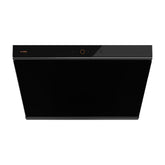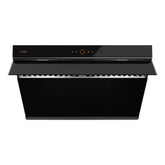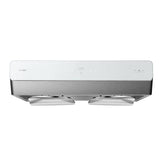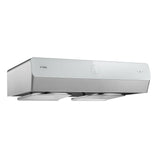How Many Watts Does an Electric Range Use? Home Cook Guide
Last Updated: 4/16/2025
Author: James Zhao, Sr. Tech Specialist & Alex Park, Product Specialist
You’re upgrading your kitchen with new appliances, but you’re wondering: how many watts does an electric range use? Whether you’re sautéing, simmering, or searing, understanding your electric stove’s power consumption can help you cook smarter, lower your energy bills, and make more sustainable choices.
This guide breaks down the average wattage of electric ranges, energy costs, and factors that influence electricity usage. You’ll also learn how to calculate cooking costs and explore options for powering your kitchen with solar energy or backup systems.
If you’re ready to level up your kitchen, FOTILE’s electric ranges reduce cooking fumes and simplify cleanup, creating a safer cooking space for your family to enjoy. Browse our full line of electric ranges and transform your kitchen with cleaner cooking.
What Is Wattage and Why Does It Matter for Cooking?
Wattage refers to the amount of electrical power your range uses while operating. Higher wattage means more energy is drawn, allowing your range to heat up cookware faster and maintain consistent temperatures. By understanding wattage, you can manage energy efficiency in the kitchen and estimate utility costs more accurately.
Watts vs. Volts vs. Amps
- Watts: Total power output. This is the number that shows up on your energy bill and reflects how much electricity your range consumes.
- Volts: This is the pressure that pushes electricity through your appliance. Most electric ranges in the U.S. run on 240 volts for fast, consistent heat.
- Amps: This is the flow of electricity. It shows how much electrical current your range is drawing to reach and maintain cooking temperatures.
Average Wattage of Electric Ranges
Electric ranges come in a variety of styles and sizes, each with its own power demands. Here's a quick look at the average wattage for electric stoves based on range type:
| Type of Electric Range | Average Wattage |
|---|---|
| Compact/Apartment-Size Range | 3,000 – 4,000 watts |
| Standard Home Electric Range | 6,000 – 8,000 watts |
| High-End Residential Range | 8,000 – 12,000 watts |
| Induction Cooktop (Standalone) | 1,400 – 3,700 watts per burner |
| Traditional Coil Cooktop | 1,000 – 2,500 watts per burner |
| Electric Oven (Standalone) | 2,000 – 5,000 watts |
These are general ranges for average use. Actual electric range power consumption depends on how many burners or heating elements are running at once.
1. Natural DIY Cleaner
A DIY oven cleaner made from baking soda and vinegar is a safe, eco-friendly option that’s tough on grime. Perfect for households with kids or pets, this method avoids harsh chemicals and is surprisingly effective.
2. Store-Bought Oven Cleaners
Commercial oven cleaning products are fast-acting and ideal for tackling heavy grease or burnt food. Look for formulas labeled “fume-free” for safer indoor use, and always follow the manufacturer’s safety guidelines.
3. Oven Self-Cleaning Mode
Modern ovens often come with a self-cleaning feature that uses high heat to incinerate residue. This high-temp cycle turns grease and debris into ash you can easily sweep out once cooled.
4. Steam Cleaning Function
Many newer ovens offer a steam clean oven setting, which uses water and low heat to soften spills and splatters for easy wipe-up. It’s a faster, less intense version of self-cleaning and great for regular upkeep.
Factors That Affect Wattage Use
The number of watts your range uses isn’t fixed—it varies depending on cooking style, appliance features, and even the cookware you use. The following factors can influence the electricity your range pulls during each meal.
- Burner Size and Quantity: Larger burners and multiple active burners increase total wattage.
- Cooking Temperature: Higher temps use more electricity than low-heat settings.
- Cooking Duration: The longer your stove or oven stays on, the more energy it consumes.
- Cookware Type and Size: Flat-bottomed, properly sized cookware transfers heat more efficiently, reducing energy waste.
- Oven Preheat and Usage: Preheating an oven or using high baking temps will increase wattage use significantly.
- Range Type: Induction cooktops are more energy-efficient compared to traditional electric coil ranges.
- Energy Efficiency Features: Modern ranges with smart sensors or eco-modes are designed to use less electricity.
How to Calculate the Electricity Cost of Your Range
By understanding the energy consumption of your stove, you can estimate the cost of cooking. Here’s a simple way to calculate cooking electricity costs:
- Find the wattage of your range or the burner you’re using (usually listed in the manual or on the appliance label).
- Convert watts to kilowatts:
- 1,000 watts = 1 kilowatt
- Example: 2,000 watts = 2 kilowatts - Multiply kilowatts by hours used to get kilowatt-hours (kWh):
- Example: 2 kilowatts × 1.5 hours = 3 kWh - Multiply by your electricity rate (check your utility bill for the cost per kWh):
- Example: 3 kWh × $0.15 = $0.45
This means that cooking with a 2,000-watt burner for 90 minutes at a rate of $0.15 per kWh would cost about 45 cents. To estimate monthly or yearly costs, multiply by how often you cook. Even a small change in usage can make a noticeable difference in your energy bill.
Power Requirements for Installation
Installing an electric range involves more than plugging it in—it requires proper wiring and voltage to function safely and efficiently:
- 240-Volt Outlet: Most electric ranges in the U.S. require a 240V outlet, more than the standard 120V used for smaller appliances.
- Dedicated Circuit: A separate circuit prevents overloads and ensures reliable performance.
- 40 to 50-Amp Circuit Breaker: Depending on the model, your range will need a circuit breaker rated between 40 and 50 amps.
- Proper Wiring: Use 8-gauge or 6-gauge wire, depending on the amperage requirements of your specific range.
- Professional Installation: Always hire a licensed electrician to install or upgrade your wiring—safety and code compliance are key.
Electric Range Usage with Solar or Backup Power
If you're using a solar energy system or backup generator, you'll need to account for the high power draw of electric ranges. Consider the following when planning your setup:
- Inverter Capacity: Make sure your inverter can handle the surge wattage during oven preheats or high-heat cooking.
- Battery Storage: You’ll need sufficient battery capacity to power your stove without interruption.
- Solar Panel Output: Calculate your daily cooking energy needs to size your solar array effectively.
- Hybrid Solutions: A mix of solar and generator backup provides flexibility for off-grid or energy-conscious homes.
Energy-Saving Tips for Cooking with an Electric Range
Small changes in cooking habits can lead to big savings. Improve your cooking energy efficiency with these simple tips:
- Match pot size to the burner to avoid heat loss.
- Cover pots and pans to trap heat and cook faster.
- Turn off burners early and use residual heat to finish cooking.
- Avoid opening the oven door while baking.
- Skip preheating when it’s not essential.
- Keep burners and ovens clean for optimal heat transfer.
- Batch cook meals to reduce overall stove and oven time.
Experience the Power and Precision of a FOTILE Electric Range
If you’re ready to transform your kitchen, FOTILE electric ranges can elevate your cooking experience. With powerful performance, easy-to-clean surfaces, and built-in features that reduce fumes, our ranges create a cleaner, safer, and more enjoyable cooking space.
Browse our full collection of electric ranges and bring precision, efficiency, and style into your kitchen.
- Choosing a selection results in a full page refresh.






